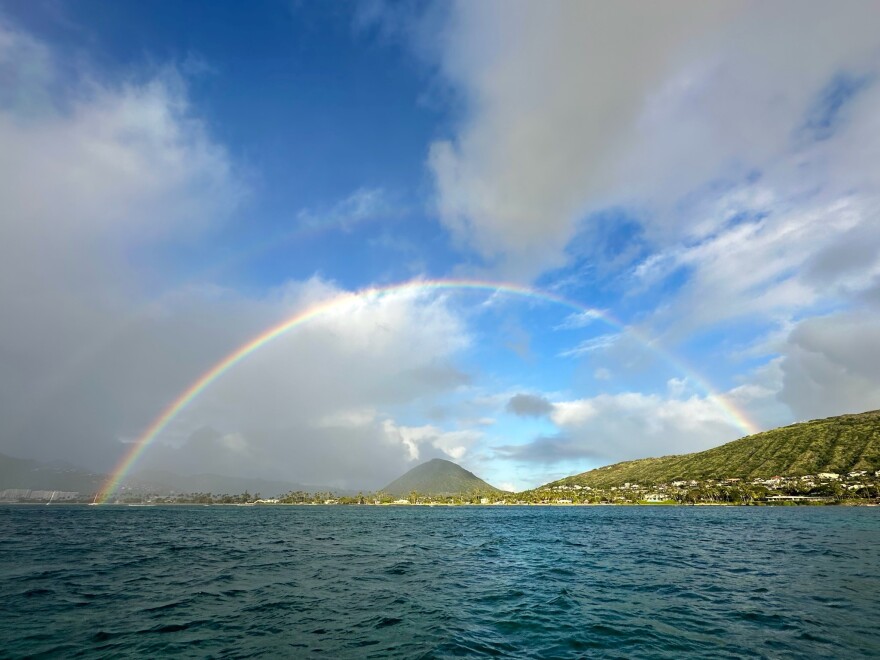Hawaiʻi's regular sunshine, short rain showers and clean air come together to create some of the planet's best conditions for viewing rainbows. They're such a frequent sight that a University of Hawaiʻi professor calls the state the “rainbow capital of the world.”
Right now it's the winter rainy season in the islands, which means the odds of seeing a rainbow are even higher than usual.
Rainbows emerge so often in Hawaiʻi they've become popular symbols of island life. Pictures of them adorn buildings, the sides of public buses and appear on standard vehicle license plates. University of Hawaiʻi sports teams are even named after rainbows.
“For me, rainbows really signify hope and new beginnings,” said Liane Usher, the president of the Children's Discovery Center in Honolulu, which features rainbows on its exterior wall and in its exploration rooms. “I can’t ever help but smile whenever I see a rainbow after the rain.”
Here are some things to know about rainbows in Hawaiʻi.
Where can I find rainbows?
Rainbows form when raindrops refract sunlight into a spectrum of colors. The brighter the sun, the clearer the rainbow.
Look for them when it is both sunny and raining at the same time. They will appear opposite the sun. They will seem larger and higher in the sky in the early morning and late afternoon, when the sun is lower on the horizon.

Steven Businger, professor of atmospheric sciences at the University of Hawaiʻi at Mānoa, says the archipelago's trade winds bring many small showers with enough blue sky between them for the sun to shine through.
Hawaiʻi's clean air also helps. Other places tend to have more air particles from dust, pollen and cars. Conditions improve further during Hawaiʻi's rainy season, which lasts from October through April.
“Hawaiʻi has maybe the best rainbows on the planet,” Businger said.
Businger created an app called RainbowChase to help people find rainbows in Hawaiʻi.
Rainbows are so prevalent that there are about 20 names for them in the Hawaiian language, according to a Mānoa website, including distinct words for rainbow fragments and those that sit low on the horizon.
What role do rainbows play in Native Hawaiian culture?
Rainbows represent divine or supernatural power in Native Hawaiian tradition.
Sam 'Ohu Gon III, senior scientist and cultural adviser at The Nature Conservancy in Hawaiʻi, said rainbows are considered a symbol of Kāne, one of the four main gods in Hawaiian tradition. Traditionally, the closer one got to a rainbow, the more likely they were to encounter a supernatural force, or an extremely powerful or chiefly person, he said.
In one centuries-old story, a rainbow appears over the secluded home of a Hawaiian princess for four straight days. Another emerges above the ocean when her suitor arrives, a man so strong his punch pierces an opponent’s chest like a spear.
To Hinaleimoana Wong-Kalu, a teacher and Native Hawaiian cultural practitioner, a rainbow signals an ʻaumakua, which is a deified ancestor or a family or personal god.
“When those of our loved ones go before us, they precede us in life and they leave us in this realm. They are able sometimes to show their presence," Wong-Kalu said. "The rainbow is one of those ways.”
Rainbows let her know spiritual protection is present and that she is loved and watched over, said Wong-Kalu, who is also known as Kumu Hina.
When did rainbows become symbols of island life?
Rainbow imagery decorates everything from buildings and restaurant facades to athletic uniforms.
The Hawaiʻi men’s athletic teams are called Rainbow Warriors and the women’s teams are Rainbow Wahine, using the Hawaiian word for women. The teams are called ‘Bows’ for short.
The origin of the rainbow mascot dates to New Year's Day in 1924. Hawaiʻi was locked in a scoreless tie against the visiting Oregon Aggies when a rainbow appeared over the field. Hawaiʻi scored soon after and reporters began calling the team the Rainbows, according to the book “Hawai'i Sports: History, Facts and Statistics.”
The Hawaiʻi football team in 2000 dropped “Rainbow” from its nickname when a coach expressed concern it carried a “stigma” because of its association with the LGBTQ+ community. The school restored the name in 2013.
Will climate change affect rainbows?
When Kimberly Carlson was a professor at Mānoa, she saw a rainbow outside her apartment window that made her wonder how climate change would affect them.
Now a New York University environmental studies professor, she's studied the impact over the next century.
Her team's analysis, published in a paper two years ago, predicts Brazil, the Mediterranean and parts of Central Africa will have fewer rainbows by 2100. They found places that currently get lots of snow, but that will instead receive more rain, will likely see more rainbows. Alaska falls in that category.
Scientists believe rainbows will continue to be plentiful in Hawaiʻi, but in the coming decades, longer dry spells might lead to fewer rainbows on the arid, leeward sides of the islands, Businger, the atmospheric sciences professor, said. Maui and the Big Island might be particularly affected, he said.
The singular experience of glimpsing a rainbow makes them worth studying, he said.
“Rainbows are a cultural touchstone for us. They cause us to stand still and for a moment, forget about the past and the future,” Businger said. “We are really in the moment when we see a spectacular rainbow, and that’s a rare experience in our busy lives.”





